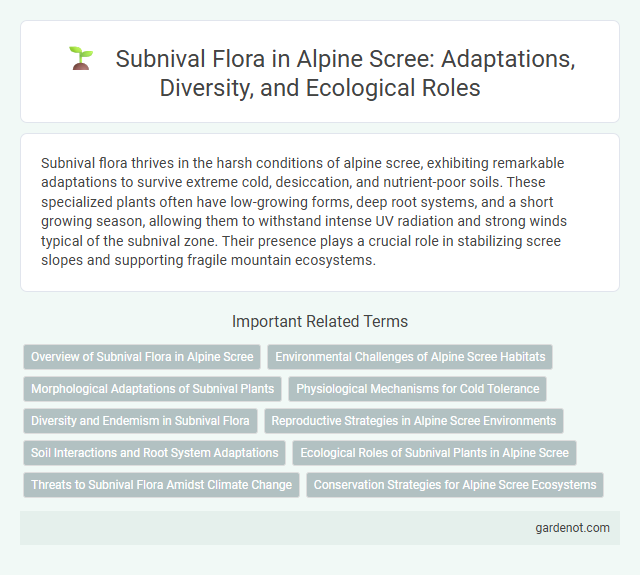Subnival flora thrives in the harsh conditions of alpine scree, exhibiting remarkable adaptations to survive extreme cold, desiccation, and nutrient-poor soils. These specialized plants often have low-growing forms, deep root systems, and a short growing season, allowing them to withstand intense UV radiation and strong winds typical of the subnival zone. Their presence plays a crucial role in stabilizing scree slopes and supporting fragile mountain ecosystems.
Overview of Subnival Flora in Alpine Scree
Subnival flora in alpine scree consists of specialized plant species adapted to extreme conditions such as low temperatures, high UV radiation, and limited soil nutrients. These plants, including cushion plants, mosses, and lichens, exhibit physiological and morphological traits like dwarfism and extensive root systems to survive in shallow, unstable scree substrates. Their presence plays a crucial role in soil stabilization and microhabitat formation, promoting ecosystem resilience above the treeline.
Environmental Challenges of Alpine Scree Habitats
Subnival flora in alpine scree habitats faces extreme environmental challenges such as low nutrient availability, high UV radiation, and fluctuating temperatures. These plants have adapted to survive in unstable, rocky substrates with poor water retention and constant mechanical disturbance from rockfalls. The harsh microclimate and rapid changes in snow cover limit plant growth and reproduction, making alpine scree ecosystems highly sensitive to climate change impacts.
Morphological Adaptations of Subnival Plants
Subnival plants in alpine scree exhibit morphological adaptations such as compact growth forms, which minimize exposure to harsh winds and reduce water loss. Their leaves often have dense trichomes or waxy coatings that protect against ultraviolet radiation and frost damage. These structural traits enhance survival in extreme high-altitude environments with low temperatures and intense solar radiation.
Physiological Mechanisms for Cold Tolerance
Subnival flora in alpine scree environments exhibits specialized physiological mechanisms for cold tolerance, including accumulation of cryoprotectants like sugars and antifreeze proteins that prevent cellular damage at subzero temperatures. These plants maintain membrane fluidity through lipid composition adjustments, enhancing cold resistance and ensuring metabolic processes continue under freezing stress. Moreover, enzymatic systems in subnival species are adapted to function efficiently at low temperatures, facilitating photosynthesis and respiration despite extreme thermal fluctuations.
Diversity and Endemism in Subnival Flora
Subnival flora exhibits remarkable diversity and endemism, thriving in harsh Alpine scree environments characterized by low temperatures and short growing seasons. Many plant species in this zone are specially adapted to survive extreme conditions, resulting in unique genetic traits and high levels of localized endemism. This biodiversity contributes crucial ecological functions, supporting soil stabilization and sustaining specialized pollinator communities in subnival habitats.
Reproductive Strategies in Alpine Scree Environments
In alpine scree environments, subnival flora employs specialized reproductive strategies such as vegetative propagation and clonal growth to ensure survival amidst harsh conditions and unstable substrates. Seed dispersal is often limited by the short growing season and low temperatures, prompting plants to invest in mechanisms like resilient seed coats and rapid germination. These adaptations optimize reproductive success and contribute to the persistence of biodiversity in extreme alpine scree habitats.
Soil Interactions and Root System Adaptations
Subnival flora in alpine scree environments exhibits specialized root system adaptations to anchor in unstable, nutrient-poor soils while maximizing water uptake from limited moisture availability. Roots develop extensive networks and symbiotic relationships with mycorrhizal fungi to enhance nutrient absorption and soil stability in harsh subnival conditions. These soil-root interactions enable plants to endure frequent freeze-thaw cycles and soil erosion typical of high-altitude scree slopes.
Ecological Roles of Subnival Plants in Alpine Scree
Subnival plants in alpine scree play a crucial role in stabilizing loose soil and preventing erosion, which supports the fragile mountain ecosystem. These plants facilitate nutrient cycling by decomposing organic matter in nutrient-poor environments, promoting soil formation and fertility. Their presence provides microhabitats for specialized insects and microorganisms, enhancing biodiversity in high-altitude scree slopes.
Threats to Subnival Flora Amidst Climate Change
Subnival flora, adapted to harsh conditions above the alpine scree, faces increasing threats from climate change, including rising temperatures and altered snowmelt patterns. These changes disrupt delicate growth cycles and facilitate encroachment by lower-elevation species, leading to habitat loss and decreased biodiversity. The fragmentation of these specialized plant communities weakens ecosystem resilience, making conservation efforts critical.
Conservation Strategies for Alpine Scree Ecosystems
Conservation strategies for alpine scree ecosystems focus on preserving subnival flora by limiting human disturbance and preventing habitat fragmentation through regulated access and protective zoning. Restoration efforts include re-vegetation with native subnival species adapted to harsh conditions and monitoring biodiversity to assess climate change impacts on these specialized plant communities. Enhanced research on species resilience and microhabitat dynamics supports adaptive management plans aiming to maintain ecological stability in alpine scree environments.
Subnival flora Infographic

 gardenot.com
gardenot.com